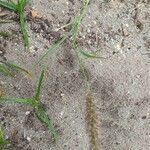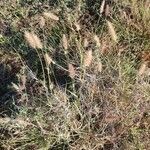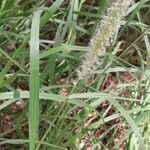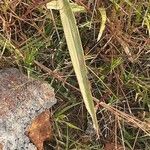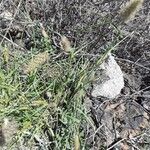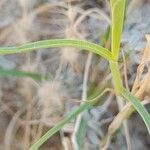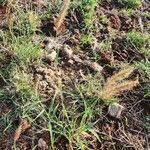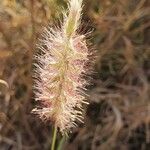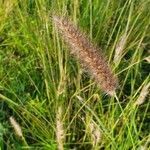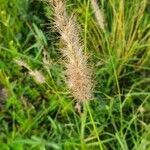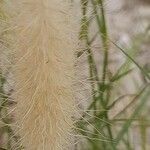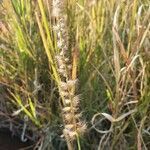Perennial, often forming mats or tussocks; culms 10–150 cm., ascending, wiry or sometimes almost woody.. Leaf-blades 3–25 cm. long, 2–13 mm. wide.. Panicle cylindrical to ovoid, 2–14 cm. long, 10–26 mm. wide, grey, purple or straw-coloured, the rhachis angular and puberulous; involucre elongate, 6–16 mm. long; inner bristles much exceeding the spikelets, one of them longer and stouter than the rest, at least the longest somewhat flattened at the base, connate only at the base to form a disc 0.5–1.5 mm. in diameter (or sometimes connate for up to 0.5 mm. above the disc’s rim), sparsely or densely ciliate below, grooved on the face or not, filiform above, flexuous, often wavy, antrorsely scaberulous; outer bristles filiform.. Spikelets 1–4 per burr, 2–5.5 mm. long, acutely lanceolate; glumes distinct, acute, the lower from 1/4–1/2, the upper from 1/2 to as long as the spikelet.
Tufted perennial, 0.6-1.0 m high. Leaf blade 100-250 x 4-8 mm. Inflorescence a bristly false spike, 40-120 mm long, purple or straw-coloured; all bristles joined at base below spikelet cluster to form a small inconspicuous disc, bristles mostly 5-10 mm long; outer bristles slender, scabrid; inner bristles slender, plumose. Spikelet 4-5 x 3 mm, dorsiventrally compressed; glumes unequal; lower glume 1-nerved or nerveless; upper glume 1-3-nerved, minutely awned. Florets 2; lower floret male or sterile, lemma usually 5-nerved, minutely awned; upper floret bisexual, lemma similar to lower lemma, not indurated, slightly thicker in texture; anther 1.5-2.7 mm long. Flowering time Aug.-Apr.
Perennial, up to 1 m tall, almost woody; culms often much branched, nodes swollen. Leaves linear, flat; ligule a fringed membrane. Inflorescence spike-like, purple; spikelets subtended by stiff, slender bristles joined at base to form a disc, usually straw-coloured below and purple above, inner bristles sparsely to densely ciliate, one longer and stouter than rest, falling with spikelet as in Pennisetum, (if bristles remain on the inflorescence see Setaria). Spikelets 4-5 mm long, 2-flowered, lower male or sterile; upper lemma similar in texture to rest of spikelet.
Tufted perennial 600-1000 mm high. Leaf blade 100-250 x 4-8 mm. Inflorescence a bristly false spike, 40-120 mm long, straw-or purple-coloured; all bristles are joined at base below spikelet cluster to form a small inconspicuous disc, bristles mostly 5-10 mm long; outer bristles slender, scabrid; inner bristles slender, plumose. Spikelet 4-5 x 3 mm; lower glume 1-nerved or nerveless; upper glume 1-3-nerved, minutely awned; lower lemma usually 5-nerved, minutely awned; lower and upper lemmas similar, upper lemma slightly thicker in texture; anther 1.5-2.7 mm long.
Perennial, tufted, up to 1 m high. Leaf blades 100-250 mm long, 4-8 mm wide. Spikelets 4-5 mm long, 3 mm wide. Inflorescence a bristly false spike, 40-120 mm long, straw-coloured or purple; bristles mostly 5-10 mm long, inner bristles slender and plumose, outer bristles slender and scabrid, all bristles joined at base below spikelet cluster to form a small inconspicuous disc.
Panicle 2–14 cm. long, cylindrical to ovoid, grey, purple or straw-coloured; involucre 6–16 mm. long, connate only at the base to form a disk 0.5–1.5 mm. in diam.; inner bristles flexuous, often wavy, sparsely to densely ciliate below, filiform above, one of them longer and stouter than the rest, this at least somewhat flattened towards the base; outer bristles filiform.
Perennial; up to 1 m high; tufted. Leaf blades 100-250 x 4-8 mm. Flowers: panicle compact; bristly; 40-120 mm long; straw-coloured or purple; bristles mostly 5-10 mm long; inner bristles slender and plumose; outer bristles slender and scabrid; all bristles joined at base below spikelet cluster to form a small inconspicuous disc; spikelets 4-5 x 3 mm.
A wiry tussocky grass. It keeps growing from year to year. It can have stolons or runners. It grows 0.2-1.5 m high. The flowers are purple. The seed head has a fluffy appearance due to long bristles.
Perennial to 1 m. Leaves linear. Spikelets in a bristly, false spike, bristles slender, 5-10 mm long, joined below spikelet, straw-coloured or purple.
Glumes distinct, acute, the inferior from 1/4–1/2, the superior from 1/2 to as long as spikelet.
Culms 10–150 cm. high, ascending, wiry or sometimes almost woody.
Spikelets 1–4 per bur, 2–5.5 mm. long, acutely lanceolate.
Perennial, culms ascending, up to about 1 in. high
Perennial, often forming mats or tussocks.
Superior lemma chartaceous.
Pending.
